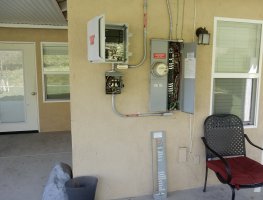jar546
CBO
I am finally writing about this incident more than 12 years after it happened. Please read and I hope you take something from it.
In the midst of a deeply emotional period, as I was keeping vigil at a hospice beside my ailing mother, I received an urgent call that would forever shape my professional stance on electrical inspections and safety. The assistant city manager of a larger municipality, where I had been subcontracting as an electrical inspector and plan reviewer, reached out to me. The urgency was palpable, especially given that it was a weekend.
I was directed to report to the local police department, where I would be escorted to the scene of a tragic accident—an electrocution in a residential setting. While en route, I was briefed on the devastating circumstances: a 14-year-old boy had been playing hide-and-seek with two girls. They had been frolicking outside, using a lawn sprinkler to cool off. The boy, with wet shorts, decided to hide behind a washer and dryer that were angled at 45 degrees, providing ample space for concealment. When the girls found him and he stood up, they heard a snapping sound and buzzing. The boy clutched his chest and uttered the haunting words, "I'm going to die," before collapsing. He was later pronounced dead at the hospital.
Upon entering the residence, the vacant expressions on the faces of the homeowners were haunting. My initial assessment led me to the basement to inspect the electrical panel. Here, it was evident that recent electrical work had been performed. Several new circuits of yellow NM cable and one orange 10/3 cable were emerging from the panel. The circuit breaker for the dryer, fed by the new orange NM cable, was already turned off.
My subsequent investigation uncovered a series of critical errors. Behind the dryer, I found a 1900 box (4x4x2-1/8" metal junction box) mounted to the drywall. An orange 10/3 NM cable entered this box, while an older, white 10/3 NM cable exited it, running along the surface where the baseboard should have been. Both cables were connected to a new 4-wire dryer receptacle that was surface-mounted to the drywall. Upon inspection, all four wires from the dryer cord were properly connected and secure. The 4-prong dryer receptacle was also correctly wired.
However, the most glaring issue was inside the 1900 box. The equipment grounding conductors (ECGs) from the new and old 10/3 cables were connected to each other but not to the box itself. There was no equipment ground pigtail or ground screw, rendering the box ungrounded. Further scrutiny revealed that one of the phases was shorted to the box, albeit not to the ground. Utilizing my Fluke digital multimeter and a megohmmeter, I ascertained that the metal Romex connector had been overtightened, causing a phase-to-box short.
Upon closer examination, I discovered that the NM cable had been aggressively cut around the jacket, which had penetrated the insulation of one of the two ungrounded conductors, also known as "hots." This aggressive cutting, combined with the overtightening of the Romex connector, created a precarious situation where the 1900 junction box was constantly electrified with 120 volts whenever the 240-volt double-pole circuit breaker was on.
The tragedy unfolded as follows: the young boy, with his wet shorts in contact with the ungrounded, electrified 1900 box, was insulated by the vinyl flooring. However, the moment he stood up and touched the grounded dryer upon being found by the girls, he completed the electrical circuit, leading to his immediate electrocution.
This incident serves as a grim testament to the critical importance of meticulous electrical inspections and adherence to safety codes. Had the installer followed code requirements by grounding the 1900 box with a pigtail and ground screw, the circuit breaker would have tripped, necessitating a fix and averting this catastrophe. Instead, a young life was cut short, and a family was shattered.
I returned to the hospice, my thoughts oscillating between the grieving family and my own mother, whom I would say goodbye to the following day. I promptly submitted my investigative report to the city, but the weight of the incident remains. It serves as a constant reminder of the life-and-death implications of our work in electrical safety. It is not just a job; it is a moral obligation to protect lives. Therefore, I implore all professionals in this field to exercise the utmost diligence. Your attention to detail could very well be the difference between life and death.
jar546
In the midst of a deeply emotional period, as I was keeping vigil at a hospice beside my ailing mother, I received an urgent call that would forever shape my professional stance on electrical inspections and safety. The assistant city manager of a larger municipality, where I had been subcontracting as an electrical inspector and plan reviewer, reached out to me. The urgency was palpable, especially given that it was a weekend.
I was directed to report to the local police department, where I would be escorted to the scene of a tragic accident—an electrocution in a residential setting. While en route, I was briefed on the devastating circumstances: a 14-year-old boy had been playing hide-and-seek with two girls. They had been frolicking outside, using a lawn sprinkler to cool off. The boy, with wet shorts, decided to hide behind a washer and dryer that were angled at 45 degrees, providing ample space for concealment. When the girls found him and he stood up, they heard a snapping sound and buzzing. The boy clutched his chest and uttered the haunting words, "I'm going to die," before collapsing. He was later pronounced dead at the hospital.
Upon entering the residence, the vacant expressions on the faces of the homeowners were haunting. My initial assessment led me to the basement to inspect the electrical panel. Here, it was evident that recent electrical work had been performed. Several new circuits of yellow NM cable and one orange 10/3 cable were emerging from the panel. The circuit breaker for the dryer, fed by the new orange NM cable, was already turned off.
My subsequent investigation uncovered a series of critical errors. Behind the dryer, I found a 1900 box (4x4x2-1/8" metal junction box) mounted to the drywall. An orange 10/3 NM cable entered this box, while an older, white 10/3 NM cable exited it, running along the surface where the baseboard should have been. Both cables were connected to a new 4-wire dryer receptacle that was surface-mounted to the drywall. Upon inspection, all four wires from the dryer cord were properly connected and secure. The 4-prong dryer receptacle was also correctly wired.
However, the most glaring issue was inside the 1900 box. The equipment grounding conductors (ECGs) from the new and old 10/3 cables were connected to each other but not to the box itself. There was no equipment ground pigtail or ground screw, rendering the box ungrounded. Further scrutiny revealed that one of the phases was shorted to the box, albeit not to the ground. Utilizing my Fluke digital multimeter and a megohmmeter, I ascertained that the metal Romex connector had been overtightened, causing a phase-to-box short.
Upon closer examination, I discovered that the NM cable had been aggressively cut around the jacket, which had penetrated the insulation of one of the two ungrounded conductors, also known as "hots." This aggressive cutting, combined with the overtightening of the Romex connector, created a precarious situation where the 1900 junction box was constantly electrified with 120 volts whenever the 240-volt double-pole circuit breaker was on.
The tragedy unfolded as follows: the young boy, with his wet shorts in contact with the ungrounded, electrified 1900 box, was insulated by the vinyl flooring. However, the moment he stood up and touched the grounded dryer upon being found by the girls, he completed the electrical circuit, leading to his immediate electrocution.
This incident serves as a grim testament to the critical importance of meticulous electrical inspections and adherence to safety codes. Had the installer followed code requirements by grounding the 1900 box with a pigtail and ground screw, the circuit breaker would have tripped, necessitating a fix and averting this catastrophe. Instead, a young life was cut short, and a family was shattered.
I returned to the hospice, my thoughts oscillating between the grieving family and my own mother, whom I would say goodbye to the following day. I promptly submitted my investigative report to the city, but the weight of the incident remains. It serves as a constant reminder of the life-and-death implications of our work in electrical safety. It is not just a job; it is a moral obligation to protect lives. Therefore, I implore all professionals in this field to exercise the utmost diligence. Your attention to detail could very well be the difference between life and death.
jar546





